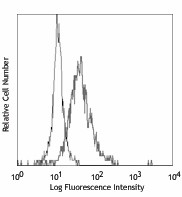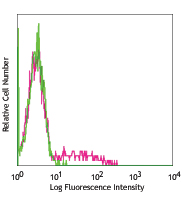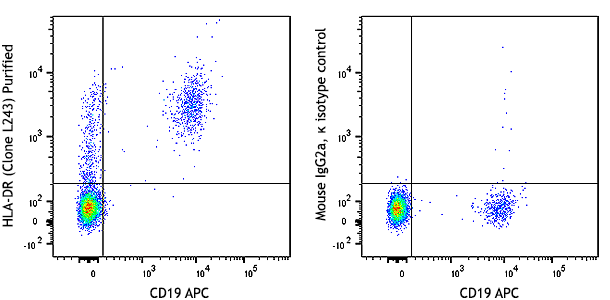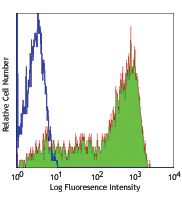- Clone
- M80 (See other available formats)
- Regulatory Status
- RUO
- Other Names
- Thrombomodulin, TM, THRM, THBD, Fetomodulin, BDCA-3
- Isotype
- Mouse IgG1, κ
- Ave. Rating
- Submit a Review
- Product Citations
- publications

-

Human peripheral blood monocytes stained with M80 PE -

LPS-stimulated (overnight) human peripheral blood mononuclear cells stained with M80 PE (gated on CD14+ cells)
| Cat # | Size | Price | Quantity Check Availability | Save | ||
|---|---|---|---|---|---|---|
| 344102 | 100 µg | 104€ | ||||
CD141 is a 75 kD, single chain, type I membrane glycoprotein also known as thrombomodulin, TM, THRM, THBD, and fetomodulin. CD141 is an important cofactor in the protein C anticoagulant system. After binding to its ligand thrombin, CD141 activates protein C, which degrades clotting factors Va and VIIIa, and as a consequence the amount of thrombin is reduced. CD141 is expressed on macrophages, monocytes, a subpopulation of myeloid dendritic cells, vascular endothelial cells, and keratinocytes. Besides anti-coagulation function, CD141 is also involved in embryonic and atherosclerotic plaque development.
Product DetailsProduct Details
- Reactivity
- Human
- Antibody Type
- Monoclonal
- Host Species
- Mouse
- Formulation
- Phosphate-buffered solution, pH 7.2, containing 0.09% sodium azide.
- Preparation
- The antibody was purified by affinity chromatography.
- Concentration
- 0.5 mg/ml
- Storage & Handling
- The antibody solution should be stored undiluted between 2°C and 8°C.
- Application
-
FC - Quality tested
- Recommended Usage
-
Each lot of this antibody is quality control tested by immunofluorescent staining with flow cytometric analysis. For flow cytometric staining, the suggested use of this reagent is ≤ 2.0 µg per 106 cells in 100 µl volume. It is recommended that the reagent be titrated for optimal performance for each application.
- Product Citations
- RRID
-
AB_2201808 (BioLegend Cat. No. 344102)
Antigen Details
- Structure
- Single chain, type I membrane glycoprotein, 75 kD
- Distribution
-
Macrophages, monocytes, subset of myeloid dendritic cells, vascular endothelial cells, keratinocytes
- Function
- After thrombin binding, CD141 activates protein C, which degrades clotting factors Va and VIIIa and reduces the amount of thrombin generated.
- Interaction
- Protein C, Thrombin-activatable fibrinolysis inhibitor (TAFI), Platelet factor 4 (PF4)
- Ligand/Receptor
- Thrombin
- Cell Type
- Dendritic cells, Endothelial cells, Macrophages, Monocytes
- Biology Area
- Immunology, Innate Immunity
- Molecular Family
- CD Molecules
- Antigen References
-
1. Suzuki K, et al. 1987. EMBO J. 6:1891.
2. Esmon CT, et al. 1989. J. Biol. Chem. 264:4743.
3. Delvaeye M, et al. 2009. N. Engl. J. Med. 361:345.
4. Shi CS, et al. 2008. Blood 112:3661.
5. Chen LC, et al. 2009. J. Infect. 58:368. - Gene ID
- 7056 View all products for this Gene ID
- UniProt
- View information about CD141 on UniProt.org
Related Pages & Pathways
Pages
Related FAQs
Customers Also Purchased



Compare Data Across All Formats
This data display is provided for general comparisons between formats.
Your actual data may vary due to variations in samples, target cells, instruments and their settings, staining conditions, and other factors.
If you need assistance with selecting the best format contact our expert technical support team.
 Login / Register
Login / Register 









Follow Us